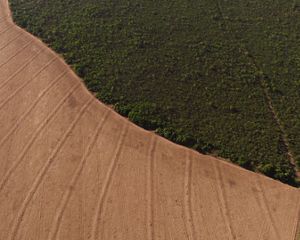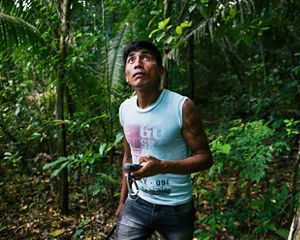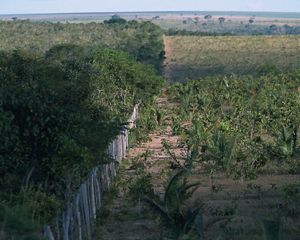
Restoring Degraded Landscapes in the Cerrado
The first phase of the Reverte Program has been completed.
THE OPPORTUNITY
Soy came to occupy a prominent place in the country's production and export agenda, reaching approximately 30% of global production, corresponding to 137 million tons in the 2020/21 harvest, according to the National Supply Company (CONAB). Half of that production is concentrated in the Cerrado, a region of immeasurable natural value due to its water reserve and biodiversity. Estimates are that the area with soy crops in Brazil, which currently total 40.4 Mha, will expand by 10.3 Mha by 2030 to meet the growing global demand (Ministry of Agriculture, Livestock and Food Supply (MAPA)/2021). That could lead to the conversion of more than 2.2 Mha of native vegetation (TNC/2020).
Ensuring soy production's sustainable growth will require increased productivity and expansion into already-cleared areas that today are mostly occupied by degraded pasturelands. The sustainable intensification of livestock production and product diversification in rural properties may optimize land use to accommodate the projected soybean expansion without the conversion of native-vegetation areas. Increasing livestock-chain productivity and ensuring coexistence with local and traditional communities in the territories are additional benefits.
That context presents a unique opportunity, given global challenges to ensure food security and tackle climate change. In the Cerrado, there are approximately 18.5 Mha of already-cleared land suitable for soy crops. Of those, 7 Mha have some degree of soil degradation (TNC/2020). That indicates enough land to accommodate the expected soy expansion without advancing over native vegetation, creating a real opportunity for progress regarding sustainable development and the consolidation of a low-carbon economy in Brazil.
The Reverte Program was created to support rural producers in recovering degraded areas through an integrated solution that involves good agricultural practices, financial tools, and input-use protocols that make fertilizers and seeds to machinery and pesticides appropriate for growing soy and other intercropped harvests. Through partnerships that share the same objectives, the Program also seeks to strengthen pre-existing projects that can contribute to the evolution and scale of regenerative agriculture in the Cerrado.
"The development of financial incentives and new technologies is fundamental to support the expansion of agriculture production without conversion of native vegetation. Through partnerships, TNC seeks to develop strategies and systemic solutions that make it possible to increase production with environmental conservation," emphasizes Rodrigo Spuri, TNC Brazil's Conservation Director.
HIGHLIGHTS OF THE PROJECT'S FIRST PHASE
Launching of the Guide for the Recovery of Degraded Lands in the Cerrado
TNC, in partnership with Embrapa and the Northern Export Corridor Research Foundation (FAPCEN) and with support from the Crop Livestock Forest Integration Network (ILPF), launched the Guide for the Recovery of Degraded Lands in the Cerrado. ]
In addition to helping producers understand the soil degradation process, the Guide suggests alternatives to restore degraded pasturelands, by implementing practices such as integrated agricultural systems (like Crop Livestock Forest Integration) and integrated pest management. Users of the Guide will be able to consult several references to help them make strategic decisions. Click here to see a video of the launching event and here to access the Guide.
Financial Solutions
TNC provided technical support to define socio-environmental and agronomic criteria for eligibility and monitoring of credit beneficiaries. TNC provided technical support to define socio-environmental and agricultural criteria for eligibility and monitoring lines of credit beneficiaries in the pilot phase. Itaú BBA manages the approach to producers, documents analysis, and aids their joining the Program.
Among the eligibility criteria analyzed by the credit line (details here) that include following current laws (environmental and labor, among others), we highlight the non-conversion of native vegetation starting in 2018 in the properties receiving financing. The grain-producing area of the property, if there is one, should not exceed 25% of the total property. A qualified technician must evaluate the state of degradation in the agricultural area using Embrapa's Manual of Procedures for Collecting Samples from Agricultural Areas for Environmental Quality Analysis. The pilot phase also required an evaluation of the climate and agricultural conditions that allow for corn and second-crop corn, verified by ZARC (Embrapa), so that the pilot follows a sustainable and profitable model. The Crop Livestock Forest Integration system will be evaluated in the next phase of the Program.
Pillars of the eligibility criteria to obtain a Reverte line of credit (click here for more details)
The eligibility and monitoring criteria, used as guidelines to obtain Reverte financing, are based on TNC's Environmental Framework, which guides users on the criteria they must adopt for soy-crop financing in the Cerrado to ensure sustainable production. Additionally, those receiving financing must have qualified technical consultants to implement environmental and agricultural practices recommended by the Program. They ensure the adoption of good agricultural practices that avoid soil degradation, enhance native vegetation conservation, and guarantee financial benefits connected to increased productivity in cleared areas.
In return for implementing production and soil management practices, which ensure less agricultural, financial, and reputational risks associated with conversion of native vegetation, the producers selected received loans with singular payment terms and rates. In the first phase of the Program and the credit line, eight producers benefited from the funds, which are being invested in 19 farms, covering a total area of 144,600 ha, of which 55,300 ha are native vegetation according to self-declared CAR information on the rural properties included in the Program. In these farms, 31.400 ha of degraded pastureland will be recovered using resources from the line of credit. The loans have a disbursement period of seven to ten years – depending on the producer's profile and choice. In the pilot phase, US$ 32.7 million will be disbursed, including resources for funding and investment.


